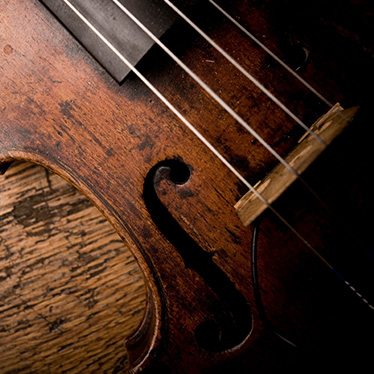What Are Violins Made Of?

Thank goodness for trees. We celebrate trees for many reasons. Mostly, people think about the vital role trees play in sustaining the environment and wildlife. And, because of trees, we have violins and other stringed instruments.
At the most basic, a violin is made of wood, which forms the body and intricate component parts, and glue. Its strings are fashioned either from cured animal intestines, steel, or synthetic material. A violin has fittings, such as tuning pegs, that can be made of wood or other materials, including plastics. This is an oversimplified view. Whether crafted in a shop by a lone luthier or mass-produced in a factory, a closer look at what violins are made of reveals a complex instrument that is truly the sum of its exquisite parts.
Different types of wood can be used to make the individual pieces of a violin. With several options available, the choices a luthier or a wholesale manufacturer makes will determine the quality of that violin. Over the years, certain woods have been identified as having desirable qualities that make them best suited for individual sections of a violin. Let’s examine them:
The Body
The largest section of the instrument, a violin’s body, or “corpus” (you don’t need to be fluent in Latin to make the translation), is actually several parts. The “top,” in which the soundholes or “f-holes” are cut, is typically made of spruce. Spruce is favored because of its density. You can shave it to the desired thinness without compromising integrity.
The back, or bottom, of the violin and the ribs that form the sides and give the instrument depth, are often made from maple. Like spruce, maple is dense and strong. As you would expect, both types of wood are great at conducting sound.
The Neck, Fingerboard – and More
Maple is also the wood of choice for the violin’s neck. Laid on top of the neck is the fingerboard. Ebony is the preferred wood for fingerboards because it’s hard enough to take the repeated hammering of a musician’s fingers. Violin makers also like ebony because of its pleasing hue, but sometimes use another type of wood and stain or paint it to look like ebony.
Fixed below the neck is a small, carefully crafted piece of maple that forms the bridge. This piece is aptly named as it keeps the violin’s strings above the fingerboard while acting as a conduit for the sound to the body. Typically, the chin rest, scroll box, and pegs are made of ebony or another type of hardwood.
Anchoring the strings to the top of the violin is a tailpiece. Once made of wood, it’s now common for the tailpiece to be fashioned from metal or synthetic material such as plastic.
Strings and the Bow
To dispel a misconception, no cats have been harmed in the manufacture of violin strings. However, for centuries, “catgut” strings were crafted from animal intestines, mostly sheep. Gut strings are now most often reserved for high-end violins. While superior in resonance quality, gut strings are not as durable as the modern steel or synthetic versions.
No violin of any quality is useful without a bow. The stick can be made from different types of wood, but composites such as fiberglass and carbon-fiber are popular choices. One thing that hasn’t changed over the years is stringing the stick with horsehair, although synthetic fiber is more often used today for its durability.
Relatively Few Materials
It should be noted that there are carbon-fiber violins available, but they do not dominate the market. For the most part, violins are made of wood, glue, and metal (mostly for the strings). Instruments made since the late 19th century have some plastic and other synthetics. For violins hand-crafted by a luthier, you can add in lots of patience and the pride of a true artist.
Are you ready for a new violin? Discover the difference between violins here.


